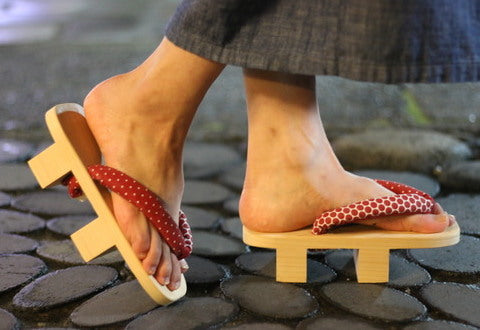The Chinese invented the Japanese traditional footwear and then came over to Japan. You won't see many Japanese people wearing traditional footwear nowadays, unless, of course, they wear a kimono. Typically, the kimono shoes are tall, lifting the wearer off the ground. The extra height also helps protect the lovely Japanese kimonos from the beginning of the walk. Tabi (socks with separate large toes) are worn to keep the feet warm and to prevent strap friction in kimono shoes.
Kimono Shoes: Geta
On two slats that raise the sole part off the ground, these sandals are made of a flat piece of wood. This is to prevent the kimono from becoming dirty. Depending on the season and garments worn, Geta can be very high or very low. High Geta, for example, can keep your kimono safe from high puddles of snow and rain.
The strap on the Geta is called Hanao and with many types of fabric it can be made. But the bestseller is cotton with traditional Japanese patterns. On the Geta, the Hanao is knotted in a unique way so that it can be replaced when needed. To prevent the wearer from walking sideways on the Geta, the Hanao is always tied in the center of the Geta. Geta are quite informal footwear and are mostly worn with a yukata and without Tabi in the summer.
Kimono Shoes: Zori
The primary distinction between Geta and Zori is that no wood is made of Zori. Zori is sleek and formal in contrast to their clunky cousin. They have a wedge-shaped shoe that is taller and coated in cotton. Never wear Geta under a Kimono, but wear Zori Kimono slippers at all times. Even if this kimono is informal.
The Zori was originally made from straw and doesn't look like the Zori kimono shoes that we see today with formal kimonos. They also grown into a dress shoe that is also very pricey. The color of your bag and Zori suits your coordination when wearing a formal kimono. This is all up to the individual's taste, of course. Even in formal environments, with your choice of kimono and colors, your individuality will come through.
Kimono Shoes: Okobo
Okobo is often referred to as the sound created while walking as pokkuri or bokkuri Geta. Only try saying "pokkuri bokkuri" a few times, it sounds like a clumping shoe to give you noise. They're pretty rare kimono shoes in typical Japanese slippers.
Actually, they are only worn by a Geisha apprentice named Maiko. These kimono shoes can be seen along the streets of Kyoto, Japan.
The strap color shows the ranking of the Maiko. You should be confident that Maiko has just started her training when you see the red strap. Not only does the height of these kimono shoes mean that the pricey kimono doesn't get dusty, but it also requires you to take short, careful steps to walk. Listen carefully to the tell-tale sound of Okubo clumping, and you'll hopefully see a local Japanese geisha walking by.
Kimono Shoes: Slippers
The only time when slippers are recommended to wear under a kimono is when wearing a Hakama. And only women are granted this right. Young females also wear a Hakama with a Furisode variation at graduation ceremonies.
The slippers worn with a low heel beneath the Hakama are rather fashionable. Japanese slippers are usually black or brown with laces that reach all the way to the top. During the Taisho period, they came into fashion when many schoolgirls wore Hakama.
EXTRA: Tabi socks
Tabi appears today in many different colors and patterns. The era of all white combination has passed. Tabi has now gone away from being unique to the kimono and is liked by Japanese for its easy fit. If you wear a casual kimono or just kimono shoes under jeans, like Geta, these socks could make a statement. Any fun gifts from Japan can also be made!
Benefits of Geta You Never Knew
Healthy for Your Feet
Geta sandals allow your feet to breathe and travel easily instead of wearing constricting footwear. It is assumed that, whether standing or walking, these slippers will help you maintain a natural pose. Its special arrangement supports the muscles of the foot and leg and enhances balance.
In reality, a team at Shizuoka University's Technology Department has shown that wearing them will trigger the acupuncture points of the foot. You would think wooden slippers would leave you with sore feet, but Geta slippers can be comfortable if worn correctly.
Eco-friendly
Wood is a resilient, recyclable and eco-friendly content. They can quickly be fixed or replaced if the thongs break. Why do non-biodegradable waste materials lead to landfills? Slippers from Geta aid maintain a greener world.
Just Look Cool
It is no mystery that Japan is one of the world's most chic and fashion-forward nations. No exception is Geta's typical slippers. These sandals come in sleek and artistic styles, unlike plastic flip-flops. Not only are they stunning, they are also realistic.
Do you like your own typical Geta Slippers? Really, you should make yourself a pair.




